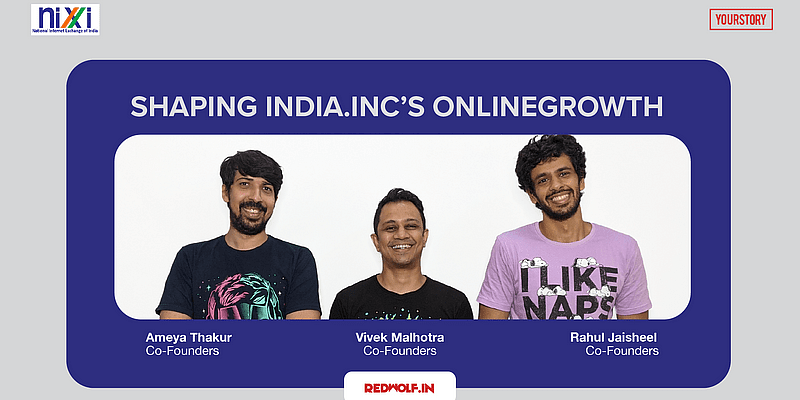Ameya Thakur belonged to a generation of Indians who had to depend on a relative or family member living or visiting from abroad if they wanted to get their hands on official fan merchandise inspired by US TV shows and films.
“Back in the early mid-2000s, official fan merchandise was yet to make a splash in Indian markets. My sister lived in San Diego, US. I used to order official fan merchandise of my favourite TV shows from American websites, get it delivered to her house and she would bring it along with her every year when she visited us,” recalls Ameya.
A chance discussion with his friends Vivek Malhotra and Rahul Jaisheel made him realise that he wasn’t the only one with the grouse. Over more discussions, the three realised that there was a business opportunity waiting to be tapped into.
The trio started building a business plan for an online clothing store that offered licensed fan merchandise of movies and TV shows at affordable prices in India and soon launched Redwolf in 2011. Over 10 years later, the three engineers-turned-entrepreneurs are leading the brand to new heights by giving the casual t-shirt a stylish makeover.
Ameya says that while they had a strong business plan there was a lot at stake. “For starters, none of us came from a business family. We had to figure out everything from scratch, like finding good vendors and reliable partners, understanding the basics of an apparel and textile business or how to set up a store and deal with legal compliances,” he adds.
At the same time, the Indian e-commerce sector was still in a nascent stage and very few buyers were using online platforms for shopping. “So, gaining the trust of our user base, making them comfortable with digital payments and introducing cash on delivery orders was like entering uncharted waters,” says Vivek.
Winning the e-commerce game with a .in domain name
The team also faced a unique challenge that was both an advantage and a potential drawback. “When we launched Redwolf, the barriers to entry for an online t-shirt brand were low. While it was easier to get the t-shirts printed and sell them, scaling the business was a particularly challenging aspect. We pooled our resources and jumped into the deep-end. Thankfully, it has worked out till now,” he adds.
A decision that the team poured a lot of thought into was choosing the domain name for their website. Given the importance of a website for an online brand, the team chose a .in extension as they felt it could help them ramp up their brand presence as an Indian entity.
The National Internet Exchange of India (NIXI) has helped hundreds of businesses like Redwolf establish themselves as a brand with its .in or .Bharat domain — which is India’s Country Code Top Level Domain (ccTLD). It’s among the few internet exchanges in the world to offer a ccTLD in multiple languages.
“A .in domain lends credibility to the brand. It represents the fact that we are a local player and are catering to the Indian market and evokes trust of customers. From an SEO point of view, it highlights our Indian connect. If someone searches for a Batman t-shirt in India online, I know Redwolf is going to rank higher than an international website on a search engine like Google or Bing,” explains Ameya.
Talking about how the Redwolf team maneuvered its way through challenges like website development and digital marketing, Vivek says, “Given that Redwolf is an online business and we are engineers, we didn’t face any problems in building the website. Plus, Ameya also has a background in search engine optimisation, so it was easy to build an accessible website.”
As the brand gained traction, Redwolf expanded to t-shirts with witty slogans and then moved on to more graphic-based apparel and finally to licensed fan merchandise. Apart from licensed merchandise, the brand is also offering t-shirts designed by independent artists from India, accessories, notebooks, mugs and masks, among other categories.
Explaining the key growth drivers in Redwolf’s journey, Vivek says the rising popularity of American and European TV shows and movies helped the brand reach out to a wider audience.
“We put a lot of thought into our designs and take them very seriously at Redwolf, which I feel gives us a competitive edge,” he says.
Agreeing, Ameya adds that while several brands might have the license to use a Batman or Iron Man logo, it’s the flavour that the team adds that sets Redwolf apart. “By selling official fan merchandise at an affordable price, we were able to rise above counterfeits that are usually sold in local markets.”
Surviving the pandemic with business resilience
Like several businesses, the COVID-19 pandemic turned out to be a rollercoaster ride for Redwolf. As sales tanked, the team wasn’t sure if they could survive as a business. “When the lockdown restrictions eased, we saw a spurt in growth as people were spending more time at home and needed casual wear. Eventually, we saw the biggest surge in sales — almost two-fold during the past year and a half — ever since we launched Redwolf,” says Vivek.
However, managing logistics amidst restrictions still remains a challenge for Redwolf.
Apart from regularly exploring new licenses, Redwolf is looking to offer more products for women over the next few years. “Currently, around 70 percent of the purchases made on our platform are by men. Having recently launched a kids’ line, we would now like to roll out more product categories specifically for women,” say the co-founders.






![Read more about the article [Weekly Funding Roundup Sept 12-16] Indian startups see sharp uptick in venture capital inflow](https://blog.digitalsevaa.com/wp-content/uploads/2022/04/weekly-funding-roundup-1640354161359-300x150.png)



